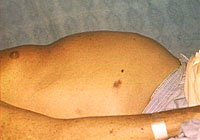| Heart Sounds & Murmurs | | | [Liver & Ascites] | | | Neck Veins | | | Pulmonary | | | Thyroid |
|
[Skill Modules
>>
Liver & Ascites
>>
Differential Dx
]
Differential Diagnosis: Liver & AscitesFalse Appearance
The following conditions may give a false positive appearance of ascites:
Abdominal distention from the above causes can usually be distinguished from ascites by examination and percussion of the flanks. In ascites, the fluid falls into the lateral and lower peritoneal spaces when the patient is supine, giving bulging flanks and flank dullness. The absence of flank dullness on careful examination of a patient with abdominal distention excludes ascites with 90% accuracy (link to Evidence-base section) Etiology of Ascites
Ascites may be differentiated by the nature of the fluid
The utility of the albumin gradient is based on the concept of oncotic-hydrostatic balance. If the patient has a high portal pressure, there will also be a high oncotic gradient, with albumin contributing the major component of serum proteins. There are large differences between serum and ascitic fluid albumin concentrations in portal hypertension, and in > 90% of cases, will be associated with a high gradient. Etiology based upon serum - ascites albumin gradientAlthough many laboratory chemistry tests may be performed, among the most useful is the serum - albumin gradient, as follows: Serum albumin - ascites albumin
For more discussion on pathogenesis of ascites, check the references. |
||||||||||||||||||||||||||||||||||||||||||||||||||||||||||||||||||||||
 Not all patients with a protruberant abdomen or history of increasing abdominal girth have ascites.
Not all patients with a protruberant abdomen or history of increasing abdominal girth have ascites.